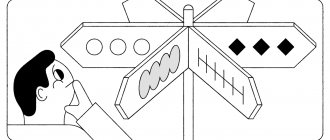According to statistics, about 7% of people sleepwalk at least once in their lives. Popularly, this phenomenon is called sleepwalking, but speaking in scientific language, it is somnambulism . A sleep disorder in which the brain wakes the body but does not stop dreams, usually occurring in childhood. But sometimes it is also observed in adults, which is a big problem. The fact is that men and women, while sleepwalking, are capable of causing damage to themselves and others, so they need careful supervision. Scientists still cannot explain the exact causes of sleepwalking, but they know many interesting facts about this phenomenon. Let's find out why people can start walking in their sleep and what to do if you or your friends experience somnambulism? The phenomenon is very interesting and to some extent dangerous, so everyone should know about it.
Sleepwalking is unlikely to harm your health, but the sleepwalker himself and those around him may well
Interesting fact: the name “sleepwalking” comes from the Latin lunaticus (mad) and luna (moon). It is due to the fact that many ancient peoples believed in the influence of lunar cycles on the human psyche.
General information
The condition, called somnambulism , noctambulism , or sleepwalking , is a parasomnia spectrum disorder. With this disorder, a person performs certain actions while being in a state of sleep. In medicine, somnambulism is considered a sleep disorder and belongs to the parasomnia .
Sleepwalking occurs when the patient does not fully awaken from the deep phase of slow-wave sleep. At the same time, the sleepwalker performs the same actions that are characteristic of waking people. Most often we are talking about fairly simple actions, such as getting out of bed or walking around the house. However, sometimes a sleepwalker commits actions that can be dangerous both for him and for the people around him. So, sometimes people suffering from somnambulism can drive a car, climb stairs, grab imaginary objects, etc. After a complete awakening occurs, it is difficult for a person to remember sleepwalking: he either has vague memories, or he does not know anything at all. remembers.
According to statistics, sleepwalking is more often recorded in children, and the frequency of such manifestations does not depend on the child’s age. According to statistics, episodes of sleep walking occur in 2-4% of adults.
Very often, in many sources you can find interesting facts about sleepwalking. For example, some people suffering from this disorder draw pictures in their sleep. Facts of murders being committed in this state have also been recorded. Moreover, after awakening, the person had absolutely no memory of his actions.
How and in whom sleepwalking manifests itself, and what those who are prone to such a disorder should do will be discussed in this article.
What advice can we give to parents?
A person suffering from somnambulism should consult a neurologist for examination and treatment.
There are many legends associated with the phenomenon of sleepwalking: it was considered a sign of madness, they argued that it was dangerous to wake up a sleepwalker and that he was acutely aware of danger and could not harm himself. It's all wrong
Somnambulism is by no means a sign of madness; It is very difficult to wake up a sleepwalker - it is better to carefully guide him back to bed; about 25% of sleepwalkers cause various injuries to themselves during night wanderings. It happens that somnambulists fall out of windows, mistaking them for doors.
Sometimes you hear stories about how people drove cars, flew airplanes and performed other complex activities while in a state of somnambulism. In fact, this is unlikely. Although, being in a state of confusion, a somnambulist is able to get into a car and start the engine, he will not be able to drive it normally due to the lack of fast reflexes at such moments - an accident will immediately occur.
In no case should you frighten a sleepwalker; you should try to carefully put him to bed or very calmly and quietly wake him up. Sleepwalking is treatable
Sleepwalking should be interrupted in the same manner as sleep - calmly, in a quiet voice.
Pathogenesis
There are two stages of sleep - fast and slow sleep. In the rapid stage, a person's eyes move under the eyelids. NREM sleep is divided into several stages: the process of falling asleep, light sleep, deep NREM sleep, especially deep sleep. If the deep sleep stage is suddenly disrupted, a person may perceive reality incorrectly and have difficulty concentrating. In this case, they talk about confused awakening or sleepy intoxication syndrome. In this state, a person may behave unusually. If at the same time he leaves the place where he slept, then such an episode is defined as sleepwalking.
REM and NREM sleep cycles alternate, with each cycle lasting approximately an hour and a half. Longer periods of slow-wave sleep are observed in the first half of the night, longer periods of fast sleep are observed in the second half. Episodes of sleepwalking usually occur during periods of deepest sleep, which is noted in the first third of the night. At the same time, the human brain is in a transitional state between wakefulness and sleep.
Scientists do not yet know why in some people such manifestations disappear with age, appearing only in childhood, while in others they do not.
Causes of sleepwalking
Today, the causes of sleepwalking in adults and children are not known for certain. However, scientists put forward different theories about why childhood sleepwalking and somnambulism develop in adults. The probable causes of this phenomenon are: an immature nervous system, disturbances in the slow-wave sleep phase, severe nervous excitement, and fatigue.
- Some experts believe that parasomnia is associated with a genetic tendency. This is confirmed by statistics, since approximately 80% of people with sleepwalking had at least one relative suffering from the same disorder. In addition, such manifestations are more often recorded in children in whom at least one parent also suffered from somnambulism.
- In addition, the connection between taking certain medications and the occurrence of episodes of sleepwalking is determined. They can be provoked by antidepressants, beta blockers, benzodiazepine receptor agonists, and antipsychotics. This connection is most clearly determined when taking Zolpidem and sodium hydroxybutyrate .
- Episodes of sleep walking have also been recorded in people with Parkinson's disease .
- The connection between sleepwalking and other sleep disorders (sleep breathing disorder in children, restless leg syndrome) has been determined.
- Sometimes somnambulism in adults can be a sign of mental disorders.
Doctors associate the causes of sleepwalking in children and adolescents, first of all, with the fact that their nervous system is not yet strong enough. Episodes of somnambulism can occur against the background of the following conditions:
- Experienced stress.
- Anxiety and tension.
- Neurosis.
- Congenital pathologies, chronic diseases.
- Suffered TBI.
- Neuroinfections.
- Epilepsy.
However, according to experts, including the famous pediatrician Komarovsky, in most cases such episodes appear in childhood, and later they are no longer observed.
Solutions
It is necessary to combat sleepwalking by identifying the cause of the pathology. After treatment for diseases of the heart, blood vessels, respiratory system, diabetes, the symptoms of somnambulism disappear. Sleepwalking does not go away when it is caused by disorders of the nervous system. Mental disorders can be cured using traditional methods and folk remedies.
Traditional methods
It is necessary to use tablets for somnambulism when sleepwalking poses a danger to the patient himself and his environment. Pharmacy medications include antidepressants, sedatives, and sedatives. Tranquilizers are prescribed for patients.
Weekly courses of Clonazepam or Nitrazepam one hour before bedtime are effective. After taking medications, it is possible that sleepwalking attacks will go away for a while. But they can return again under certain situations. You can completely get rid of sleepwalking using additional methods.
Relax with folk remedies
A disease associated with nervous overstrain can be cured by relaxation methods. Taking baths with essential oils of mint, lemon balm, sweet clover, and sage before bedtime relieves nervous tension and allows you to sleep deeply and peacefully. Signs of sleepwalking are eliminated within 10-15 procedures. The temperature of the water in the bath is 36 degrees, the residence time is 10-15 minutes.
If a person suffers from a sleep disorder due to depression or increased nervous excitability, then you can take the following infusion before bed:
- spring primrose flowers;
- lemon balm;
- blue cyanosis rhizomes, a tablespoon 2 hours after eating;
- hop cones;
- peppermint.
Yoga classes under the supervision of a specialist are very calming.
Symptoms of sleepwalking
The following symptoms are characteristic of somnambulism:
- Absence of memories of the sleepwalking episode, or they are very scarce and unclear.
- A person may have open eyes, but their expression is dull and glassy.
- The duration of a sleepwalking attack can range from 30 seconds to 30 minutes. Sometimes, in rare cases, the attack lasts for several hours.
- When sleepwalking, a person is clumsy, so he can trip, fall and injure himself.
- Upon awakening, the person feels confused and disoriented.
- As for the frequency of episodes, it varies from person to person - from sleepwalking only on rare occasions to several episodes per night.
Signs in children appear similarly. However, often signs of sleepwalking are noted only in childhood, and as the child grows older, they disappear.
Tests and diagnostics
As a rule, a person in whose life there are episodes of sleepwalking learns about it from other people, since he himself most likely does not remember such manifestations.
During the diagnostic process, the doctor evaluates the clinical picture, which is mainly reported by the patient’s relatives. It is important for a specialist to find out how often such episodes occur and what precedes them. It is also important to determine whether moments of sleepwalking remain in a person’s memory.
If such episodes occur regularly, the patient is prescribed a full neurological and psychiatric examination. Among other things, the following methods are practiced:
- CT or MRI of the brain.
- Electroencephalography.
- Polysomnography.
During the examination, it is important to differentiate true somnambulism from similar manifestations in epilepsy .
Drug treatment
According to individual indications, the patient may be prescribed sedatives or sleeping pills, and in some cases tranquilizers are used. The choice of drug therapy is a very important moment; the specialist takes into account many factors before prescribing this or that drug.
If the patient has vascular, neurological, endocrine or cardiac diseases, therapy focuses on treating the underlying disease. For example, if the cause of sleepwalking is attacks of severe arrhythmia, then it is the heart disease that should be treated. In cases where the problem is caused by brain tumors, surgery will likely be required.
Mainly during treatment, it is important to create conditions under which a person will feel calm and confident. You can relieve fatigue and anxiety using physiotherapeutic methods and relaxation practices.
Prevention
To prevent manifestations of somnambulism, those who are prone to it should practice the following preventive measures:
- Before going to bed, you should not practice physical activity or do exercises.
- You should sleep 7-8 hours a day. Both excessive sleep and lack of sleep are contraindicated.
- You should give up bad habits - smoking, drinking alcohol.
- For a child suffering from sleepwalking, it is very important to create a calm, friendly atmosphere in the family and protect him from stress.
- You should limit your TV viewing and time spent in front of gadget screens.
- If you suspect the development of diseases of the nervous system and psyche, you should immediately consult a doctor.
Treatment of somnambulism
In children, the disease goes away on its own as the brain grows and develops. Treatment of a child suffering from somnambulism most often comes down to correcting the daily routine, nutrition and psychological stress.
In the case of an illness in an adult, the treatment process is not so simple and straightforward, since the reasons for its origin are much deeper and more serious. Sleepwalking therapy is carried out using psychotherapy and medications. If attacks of night movements appear after stress, emotional or mental stress, then first of all the help of a psychologist or psychotherapist is needed.
In children
If a child is prone to sleepwalking, parents should behave appropriately during such episodes. If the baby tries to go somewhere, he should be calmly escorted back to bed. Interrupting his sleep should only be done as a last resort. However, you can talk to your child quietly and calmly.
It is also important to avoid conflicts in the family and try to create a trusting and warm atmosphere.
Finally, parents should not perceive their child's sleepwalking as something scary. It is important to carefully monitor him, analyze the situation, and it is quite possible that the baby will “outgrow” this disease.
How to Avoid Injury
In families where a sleepwalker lives, measures must be taken to avoid the dangerous consequences of sleep disturbance. For this they try:
- monitor the behavior of the somnambulist;
- block doors;
- put bars on the windows;
- cut off sharp corners on tables;
- remove chairs and breakable objects at night;
- Do not scatter electrical wires around the room;
- hide small items, keys.
If it is difficult to keep track of the sleepwalker, then it is better to call an ambulance in case of injury or a dangerous situation.
Diet
Diet for the nervous system
- Efficacy: therapeutic effect after 2 months
- Timing: constantly
- Cost of food: 1700-1800 rubles per week
Both adults and children who experience such manifestations should eat properly and rationally. The diet should be varied. It is advisable not to consume alcohol. Also in the afternoon you should not drink drinks that stimulate the nervous system. It is worth giving up tea and coffee.
List of sources
- Large medical encyclopedia in 30 volumes/chapter. ed. B.V. Petrovsky. 3rd ed. M.: Soviet Encyclopedia, 1982. T. 23. P. 513-520.
- Golbin A.Ts., Guzeva V.I., Shepovalnikova. Unusual forms of sleep behavior as “compensatory” reactions of the body aimed at normalizing the wake-sleep cycle // Human Physiology. 2013. T. 39. No. 6. P. 83.
- Levin Ya.I. Sleep disorders. In: National Guide to Neurology. Ed. Guseva E.I., Konovalova A.N., Skvortsovoy V.I., Gekht A.B..M., “Geotar-Media”, 2009, p. 548-565.










